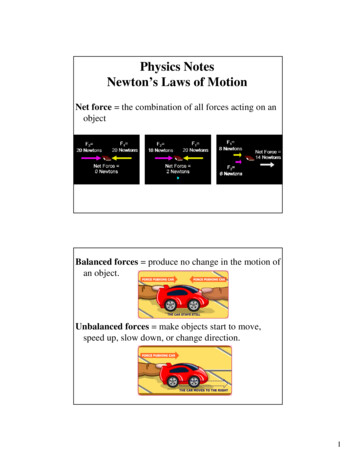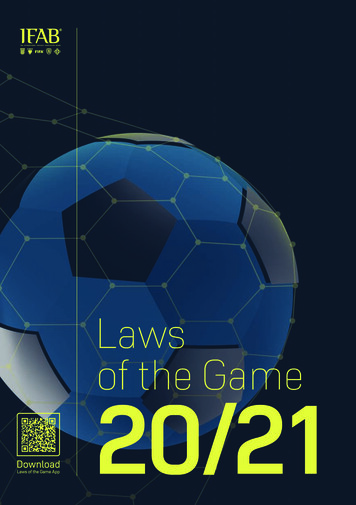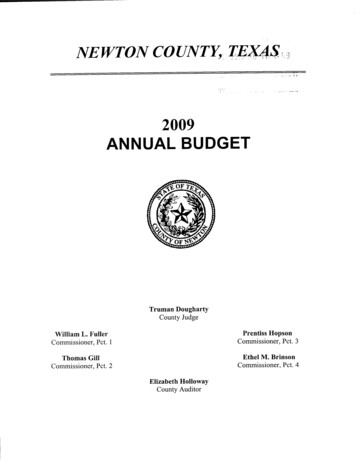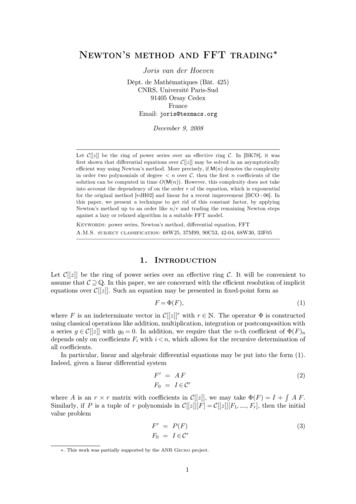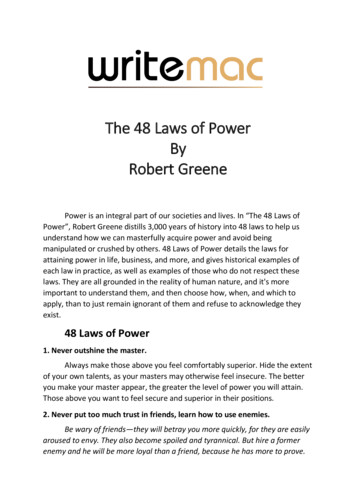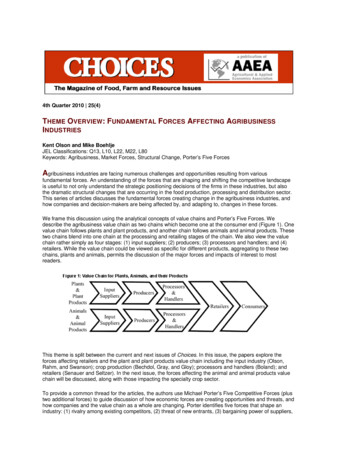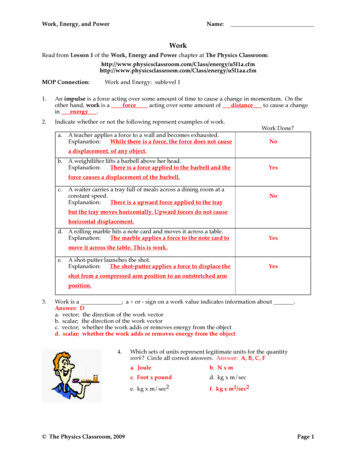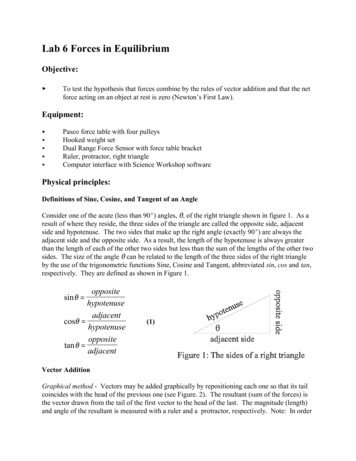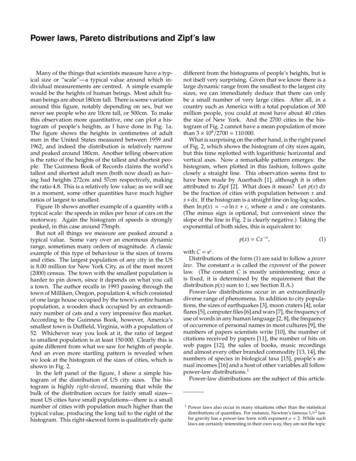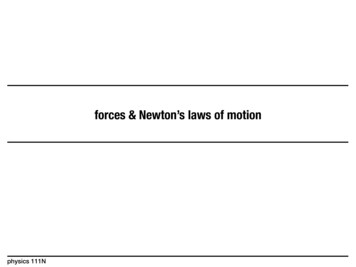
Transcription
forces & Newton’s laws of motionphysics 111N
forces (examples)a push is a forcea pull is a forcegravity exerts a forcebetween all massive objects(the force of attraction(without contact)from the Earth is calledthe weight force)physics 111N2
contact forcesa normal force occurswhen an object pusheson a surfacethe force is perpendicularto the surfacea friction force canoccur parallel to thesurface of contactphysics 111N3
force vectorsforces have magnitude(measured in Newtons, N)and directione.g.physics 111N4
pulling a fridge - resultant forcetwo guys are moving a fridge by pulling on ropes attached to itSteve is very strong, Walter is much weakerphysics 111N5
pulling a fridge - resultant forcetwo guys are moving a fridge by pulling on ropes attached to itSteve is very strong, Walter is much weakerthe pair of forces can be replaced by one single force in thedirection of the sum of forces with the magnitude of the sumphysics 111N6
components of a forcephysics 111N7
Newton’s first law! Isaac Newton first proposed the following law ofnature to attempt to describe objects in motion“ Every object continues either at rest or in constant motionin a straight line unless it is acted upon by a net force “a.k.a ‘inertia’the statement about objects at rest is pretty obvious,but the “constant motion” statement doesn’t seem rightaccording to our everyday observations1687physics 111N8
Newton’s first law & friction“ Every object continues either at rest or in constant motionin a straight line unless it is acted upon by a net force “the problem is we can’t easily test the law, becausewe can’t set up a situation where there is no forcefriction is ubiquitouswe can try to minimise friction thoughphysics 111N9
curling & inertiaphysics 111N10
Newton’s second law! The first law describes what happens when no force acts on an object! The second law describes the response of the object to a force being appliedwe know that different objects responddifferently to the same magnitude of force! push a shopping cart! push a freight train! very different responses“ The acceleration of an object is directly proportional tothe resultant force acting on it and inversely proportionalto its mass. The direction of the acceleration is thedirection of the resultant force. ”or, in a much more compact notation,physics 111N12
Newton’s second law“ The acceleration of an object is directly proportional tothe resultant force acting on it and inversely proportionalto its mass. The direction of the acceleration is thedirection of the resultant force. ”! OK, so to move an object at rest we need to accelerate itmeans there must be a net force acting on the object! to change the velocity of an object, we need to accelerate itmeans there must be a net force acting on the object the first lawis just whenso! the mass of an object determines how much acceleration you get for a given force! push a shopping cart (m is small) ! big acceleration! push a freight train (m is big)! small accelerationphysics 111N13
“the” unit of force! the Newton, N, is defined to be the force required to impart anacceleration of 1 m/s2 to a 1 kg massthere are other units, e.g. pounds (lb) we could use,but let’s stick to SI (“metric”) for nowphysics 111N14
using F ma! a worker with spikes on his shoes pulls with a constant horizontal force of magnitude20 N on a box of mass 40 kg resting on the flat, frictionless surface of a frozen lake.What is the acceleration of the box ?physics 111N15
mass & weight! we need to be careful to distinguish these terms! mass is related to the amount of matter (“stuff”) in an object! weight is specifically the force on an object from the gravitational attraction of the Earthare mass and weight related ?experimentally we found that all objects in free-fall acceleratetoward the Earth with acceleration of magnitudetrue for all objectsbut the value of g is a property of the Earth,it wouldn’t be the same value on the Moonphysics 111N16
normal force (at equilibrium)! consider the forces on a box sitting at rest on the floor! the weight force points downbut this can’t be the only force on the box- if it was it would accelerate downwards !! the normal force points upwardthe box compresses the surface of the floor at themicroscopic level and the floor pushes back physics 111N17
Newton’s third law“ To every action there is always opposed an equal reaction ”if an object A exerts a force on object B, object B exertsa force of equal magnitude and opposite direction on Aphysics 111N18
normal forces & Newton’s third law! box A sits on top of box B at restnormal forceon A from BAABBnormal forceon B from Aphysics 111N19
all the forces! box A sits on top of box B at restwhat forces act on box A ?normal forceon A from BABweight of Aequal & opposite because thebox is at rest - the first lawphysics 111N20
all the forces! box A sits on top of box B at restwhat is the third law reaction force to the normal force on A from B ?normal forceon A from BABnormal forceon B from Aequal & opposite because ofthe third law - N.B. forces acton different objectsphysics 111N21
all the forces! box A sits on top of box B at restwhat is the third law reaction force to weight of A ?ABweight of A“ force of theEarth on A ”“ force of Aon the Earth ”so just as the Earth attracts you toward it, you attract the Earth toward youphysics 111N22
all the forces! box A sits on top of box B at restis the normal force on A the reaction force to the weight of A ?normal forceon A from Bnormal forceon A from BNO !AABBweight of Aweight of A“ force of Aon the Earth ”they are equal & opposite,but they aren’t an action-reaction pairphysics 111Nremove box B & the normalforce goes away23
bathroom scales! your bathroom scales measure the force you exert on the scalesthe reaction force ofthis is the normal forceof the scales on younormal forceon youfrom scalesyou also have yourweight forcenormal forceon youfrom scalesnormal forceon scalesfrom youbut if you’re at rest &remain at rest, youracceleration is zeroyour weightphysics 111N& thus the scalesmeasure your weight25
losing weight the easy way! now suppose you stand on bathroom scales while riding an elevator elevator accelerating downsmaller reading on the scalesyou “lost weight”physics 111N elevator accelerating uplarger reading on the scalesyou “gained weight”26
ropes & tension! consider a uniform rope whose ends are being pulled on! look at a small section with mass mNewton’s 2nd law appliedto this section of rope! rope in equilibrium (not accelerating), TR TL & tension same throughout! rope is massless, TR TL & tension same throughoutwe will usually assume ropes to be effectively massless or inequilibrium such that the tension is the same throughout the ropephysics 111N30
systems in equilibrium in more than one dimension! here by ‘in equilibrium’, we mean at rest or moving with constant velocity! in that caseand by Newton’s second law! or “all the forces on anobject must balance”really just Newton’s first law! it is often helpful to split the problem up into componentsphysics 111N31
two-dimensional equilibrium! a car engine of mass 500 kg hangs at restfrom a set of chains as shown. Find the tension ineach chain, assuming their masses are negligible.for theenginephysics 111Nfor thering32
two-dimensional equilibrium! a car engine of mass 500 kg hangs at restfrom a set of chains as shown. Find the tension ineach chain, assuming their masses are negligible.for theenginephysics 111Nfor thering33
systems out of equilibrium! here by ‘in equilibrium’, we mean at rest or moving with constant velocity! so systems out of equilibrium have an acceleration! and we must use Newton’s second law in full! it is often helpful to split the problem up into componentsphysics 111N36
the sliding box! a box slides down a frictionless incline sloped at a constantangle of θfind the acceleration of the box and thenormal force exerted by the slope on the boxfree-body diagramfor the boxphysics 111Nexpress in components paralleland perpendicular to the slope37
the sliding box! a box slides down a frictionless incline sloped at a constantangle of θfind the acceleration of the box and thenormal force exerted by the slope on the boxexpress in components paralleland perpendicular to the slopebox acceleratesdown the inclinebox doesn’t moveoff the inclineas a cross-check,consider θ 0,90 physics 111N38
the Atwood machine! consider this experimentphysics 111N39
the Atwood machine! let’s explain the measurement using our theory of forcesphysics 111N40
friction! we already considered one contact force present when two surfaces touch, namely thenormal force, which acts perpendicular to the surfaces! in some cases there can be a contact force parallel to the surfaces known as thefriction force! friction is everywhere . let’s build a simple model to describe it! two forms of friction - static (not moving) & kinetic (moving)physics 111N41
frictionno applied force,box at restno friction forcephysics 111N42
frictionsmall applied force,box at reststatic friction forcestatic friction forcematches the pull force &keeps the box at restphysics 111N43
frictionlarger applied force,box at reststatic friction forcestatic friction forceincreases to match the pullforce & keep the box at restphysics 111N44
frictioneven larger applied force,box moving at constantspeedkinetic friction forceeventually the static frictionforce cannot get any larger& the box will start to moveonce the box is movingthere will be a constantkinetic friction forcephysics 111N45
frictionno applied force,box at restno friction forcesmall applied force,box at reststatic friction forcestatic friction forcephysics 111Nlarger applied force,box at reststatic friction forceeven larger appliedforce,box moving atconstant speedkinetic friction forcekinetic friction force46
frictionstatic friction forcekinetic friction force! the magnitudes of fsmax and fk are determined byproperties of the two surfaces in contact and can beexpressed via coefficients of frictione.g.physics 111Nmaterialsrubber onconcretewood onconcretesteel onTeflon47
elastic forces! springs & Hooke’s lawan empirical, approximate lawphysics 111N52
a spring balance! we can use Hooke’s law to build a device to measure weightcalibrationfor this spring every centimeter ofextension means 12 N of weightphysics 111N53
a spring balance! we can use Hooke’s law to build a device to measure weightmeasurementphysics 111N54
springs and weights! three identical masses are hung by three identical massless springs! find the extension of each spring in terms of the mass, m, thespring constant, k and gphysics 111N55
springs and weights! three identical masses are hung by three identical massless springs! find the extension of each spring in terms of the mass, m, thespring constant, k, and g#!"#"!physics 111N56
springs and weights! three identical masses are hung by three identical springs! if the unextended length of the springs are 10.0 cm, the springconstant is 8.00 kN/m and the masses are 14.00 kg each, find thelengths of each spring in equilibriumphysics 111N57
physics 111N 2 forces (examples) a push is a force a pull is a force gravity exerts a force between all massive objects (without contact) (the force of attraction from the Earth is called the weight force) physics 111N 3 c
